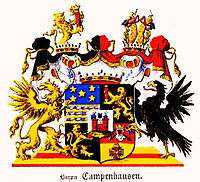Balthasar von Campenhausen
| Freiherr Balthasar von Campenhausen | |
|---|---|
.jpg) | |
| Born |
5 January 1772 Lenzenhof, Livonia, Russian Empire |
| Died |
11 September 1823 (aged 51) Saint Petersburg, Russian Empire |
| Occupation | statesman |

Balthasar Freiherr[1] von Campenhausen (Russian: Балтазар Балтазарович (фон) Кампенгаузен, Balthasar Balthasarovich (von) Kampengauzen) (1772, Lenzenhof, –1823) was a Baltic German statesman who held the ranks of Privy Councilor and Chamberlain in the Russian Empire.
Balthasar Freiherr von Campenhausen was born in 1772 into a Baltic German noble family Campenhausen residing in the province of Livonia (then part of Imperial Russia, now Latvia and Estonia). The ancestors of Balthasar Campenhausen served Swedish and Russian sovereigns. He studied in the universities of Leipzig, Wittenberg and Göttingen that he graduated with a thesis Entwürfe zu physikalischen Völker-, Religions— und Kulturkarten des russischen Reiches at the Royal Scientific Society. Balthasar Campenhausen served as ambassador to Poland and Sweden, headed reorganization of the commercial school and medical surgery institution in Saint Petersburg and during the rule of Alexander I of Russia, he was appointed director of the 3rd Department (medical dept.) at the Russian Ministry of Internal Affairs. In 1802, Russian Emperor Alexander I of Russia sent Campenhausen to the South Russian seaports on Black and Azov Sea to see the reasons for poor trade development and to provide quarantine conditions in the South of Russia during the outbreak of bubonic plague in Turkey and Persia.
In 1805, Balthasar von Campenhausen was appointed Governor of Taganrog, where he created: the Taganrog Customs district; the new slope to the haven; new stone storehouses for goods; started construction of coasting vessels for transportation of goods to other Russian ports on Black and Azov Seas; inaugurated the navigation school, the commercial gymnasium and the commercial court; opened the first drugstore and introduced the posts of the city doctor and city midwife; opened the construction and building committee that planned the future city architectural development; introduced oil lighting in the streets; started the paving and greening of the streets; in April 1806 founded the City Park. Two streets in Taganrog were later named after Campenhausen: Bolshoy Campenhausenskiy (now: Comsomolskiy) and Malo-Campenhausenskiy (now: Spartakovskiy).
In 1809, Campenhausen was named the State Treasurer, Privy Councilor in 1810, member of the State Council and senator in 1811, and Minister of Internal Affairs in 1823. He died in Saint Petersburg in 1823.
Bibliography
- Versuch einer geographisch-statistischen Beschreibung der Statthalterschaften des russischen Reichs. I. Statthalterschaft Olouez (Göttingen, 1792);
- Elemente des russischen Staatsrechts, oder Hauptzüge der Grundverfassung des russischen Kaiserthums (Göttingen, 1792);
- Auswahl topographischer Merkwürdigkeiten des St. Peterburgischen Gouvernements (Riga, 1797);
- Liefländisches Magazin, oder Sammlung publicistisch-statistischer Materialien zur Kenntniss der Verfassung und Statistik von Liefland (Gota, 1803);
- Genealogisch-chronologische Geschichte des allerdurchla uchtigsten Hauses Romanow und seines vorä lterlichen Stammhauses (Leipzig, 1805).
| Political offices | ||
|---|---|---|
| Preceded by Viktor Kochubey |
Minister of Interior June 1823 – August 1823 |
Succeeded by Vasily Lanskoy |
| Government offices | ||
| Preceded by Apollon Dashkov |
Governors of Taganrog 1805–1809 |
Succeeded by Pyotr Papkov |